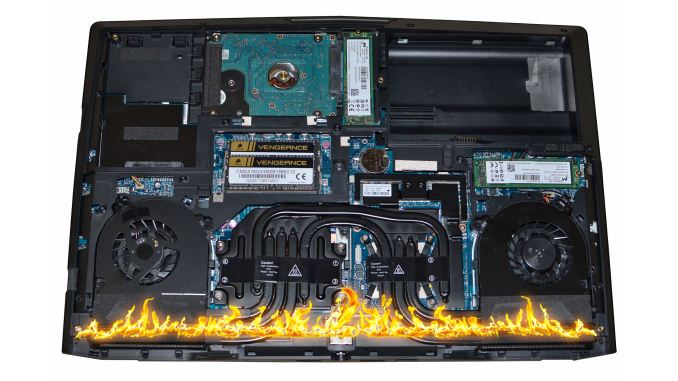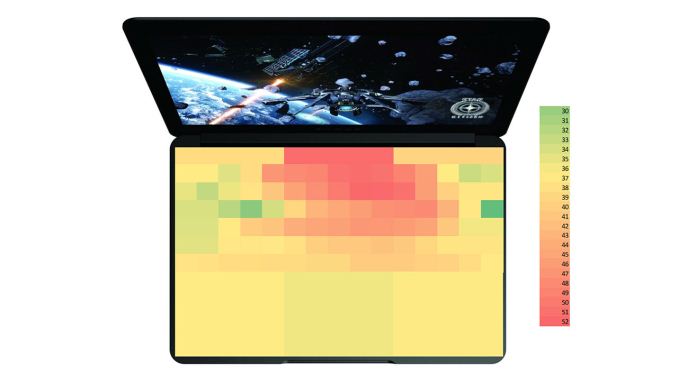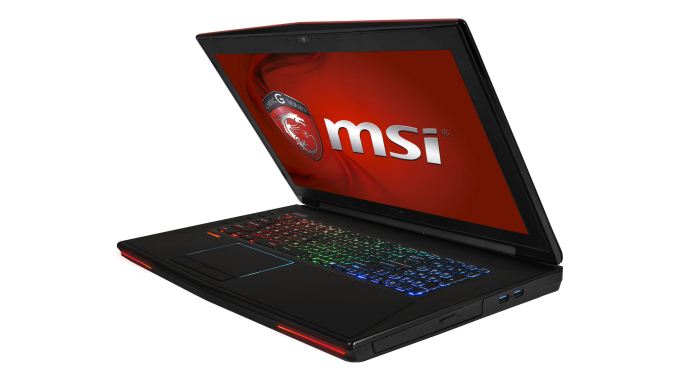NVIDIA Mobile Overclocking - There and Back Again
by Jarred Walton on February 20, 2015 2:25 PM EST- Posted in
- Laptops
- Gaming
- NVIDIA
- Overclocking
- Notebooks

The past few months have been a bit interesting on the mobile side of the fence for NVIDIA. Starting with the R346 drivers (347.09 beta and later), NVIDIA apparently decided to lock down overclocking of their mobile GPUs. While this is basically a non-issue for the vast majority of users, for the vocal minority of enthusiasts the reaction has been understandably harsh. Accusations have ranged from “bait and switch” (e.g. selling a laptop GPU that could be overclocked and then removing that “feature”) to “this is what happens when there’s no competition”, and everything in between.
NVIDIA for their part has had a few questionable posts as well, at one point stating that overclocking was just “a bug introduced into our drivers” – a bug that has apparently been around for how many years now? And with a 135MHz overclocking limit no less…. But there’s light at the end of the tunnel, as NVIDIA has now posted that they will be re-enabling overclocking with their next driver update, due in March. So that’s the brief history, but let’s talk about a few other aspects of what all of this means.
First and foremost, anyone that claims enabling/disabling overclocking of mobile GPUs is going to have a huge impact on NVIDIA’s bottom line is, in my view, spouting hyperbole and trying to create a lot of drama. I understand there are people that want this feature, and that’s fine, but for every person that looks at overclocking a mobile GPU there are going to be 100 more (1000 more?) that never give overclocking a first thought, let alone a second one. And for many of those people, disabling overclocking entirely isn't really a bad idea – a way to protect the user from themselves, basically. I also don’t think that removing overclocking was ever done due to the lack of competition, though it might have had a small role to play. At most, I think NVIDIA might have disabled overclocking because it’s a way to keep people from effectively turning a GTX 780M into a GTX 880M, or the current GTX 980M into a… GTX 1080M (or whatever they call the next version).
NVIDIA’s story carries plenty of weight with me, as I’ve been reviewing and helping people with laptops for over a decade. Their initial comment was, “Overclocking is by no means a trivial feature, and depends on thoughtful design of thermal, electrical, and other considerations. By overclocking a notebook, a user risks serious damage to the system that could result in non-functional systems, reduced notebook life, or many other effects.” This is absolutely true, and I’ve seen plenty of laptops where the GPU has failed after 2-3 years of use, and that’s without overclocking. I've also seen a few GTX 780M notebooks where running at stock speeds isn't 100% stable, especially for prolonged periods of time. Sometimes it’s possible to fix the problem; many people simply end up buying a new laptop and moving on, disgruntled at the OEM for building a shoddy notebook.
For users taking something like a Razer Blade and trying to overclock the GPU, I also think pushing the limits of the hardware beyond what the OEM certified is just asking for trouble. Gaming GPUs and “thin and light” are generally at opposite ends of the laptop spectrum, and in our experience the laptops can already get pretty toasty while gaming. So if you have a laptop that is already nearing the throttling point, overclocking the GPU is going to increase the potential of throttling or potentially even damage the hardware. Again, I’ve seen enough failed laptops that there’s definitely an element of risk – many laptops seem to struggle to run reliably for more than 2-3 years under frequent gaming workloads, so increasing the cooling demands is just going to exacerbate the problem.
On the other hand, if you have a large gaming notebook with a lot of cooling potential and the system generally doesn't get hot, sure, it’s nice to be able to push the hardware a bit further if you want. Built-in throttling features should also protect the hardware from any immediate damage. We don’t normally investigate overclocking potential on notebooks as it can vary even between units of the same model, and in many cases it voids the warranty, but enthusiasts are a breed apart. My personal opinion is that for a gaming laptop, you should try to keep GPU temperatures under 85C to be safe (which is what most OEMs tend to target); when laptops exceed that “safe zone” (with or without overclocking), I worry about the long-term reliability prospects. If you have a GPU that’s running at 70C under load, however, you can probably reliably run the clocks at the maximum +135MHz that NVIDIA allows.
We’re currently in the process of testing a couple of gaming notebooks, and given the timing of this we’re going to use this as an opportunity to try some overclocking – with the older 344.75 drivers for now. We’ll have a separate article digging into the overclocking results later, but again I’d urge users to err on the side of caution rather than trying to redline your mobile GPU. What that means in practice is that mobile GPU overclocking is mostly going to be of use for people with larger gaming notebooks – generally the high-end Alienware, ASUS, Clevo, and MSI models. There may be other laptops where you can squeeze out some extra performance (e.g. some models with GTX 850M/860M, or maybe even some older GT 750M laptops), but keep an eye on the thermals if you want to go that route.












36 Comments
View All Comments
watermark0n - Monday, February 23, 2015 - link
My GPU by default is set to throttle at 110 Degrees C. It is by no means safe to run the GPU constantly at or near boiling point, that's just where it is unsafe to even run it temporarily. You should not rely on that, don't be an idiot.Cakefish - Saturday, February 21, 2015 - link
As one of those minority enthusiasts myself, I am interested in seeing your laptop overclocking article. My own 980M handles +135/+200 like a champ and rarely exceeds 70°C - in a chassis that's only 28.8mm thick, so think what the even beefier models can achieve!JarredWalton - Saturday, February 21, 2015 - link
Which laptop is that?rtho782 - Saturday, February 21, 2015 - link
I have an Alienware M14xR2. The GPU is a 650m, with 2GB of GDDR5 on a 128bit interface.I usually overclock the ram by 50%, from 1000mhz to 1500mhz (so 4000 to 6000MT/s) and the GPU from 745mhz to 1000mhz.
This makes a massive difference in performance to me, and I wouldn't use any GPU drivers that lock out my overclock. In fact, it puts me in 660m territory, and has been fine for over 2 years of heavy use.
obsidian24776 - Saturday, February 21, 2015 - link
To much defence of Nvidia's shady practices when oems are advertising gaming laptops with overclocking as a feature especially as this bait and switch deflects from their other false advertising escapadesJarredWalton - Saturday, February 21, 2015 - link
If the OEMs are advertising the feature -- no NVIDIA -- then why is this a shady practice by NVIDIA? And you'll note it's being rolled back so overclocking will return.Regarding the "other false advertising" bit, as an owner of two 970 cards that "only" have 3.5GB of high-performance RAM, I can also say that the whole thing has been a bit silly. Performance didn't change at all, and the number of cases where the extra 512MB RAM would make a real difference is trivially small. If a game actually exceeds 3.5GB RAM use, it's going to be dangerously close to 4GB anyway, and the difference between 4GB and 2GB in texturing is virtually impossible to spot.
Seriously: from Far Cry 4 to Assassin's Creed Unity to Dragon Age Inquisition, you can turn the texture quality down one step from maximum but leave everything else at max, and in practice the only way to see any difference is to take screen shots and carefully look for minor variations.
zodiacfml - Saturday, February 21, 2015 - link
It's just a matter of how strict they are with the cooling requirements and how well they are designed. I still have a phobia with any kind of GPU on a laptop as they fail too often. Yet.....A well designed mobile GPU should be able to increase its fan and throttle at the same time to enhance reliability/longevity. Overclocking should give more noise or throttle more often and gives users something to play with such as custom cooling systems for notebooks to improve on the issue. It's a win for everyone, Nvidia or AMD shouldn't be too lazy or too scared of it.
qasdfdsaq - Saturday, February 21, 2015 - link
I have to say this article seems to be pretty misdirected. Nearly every justificaition raised for disabling overclocking on laptops applies *exactly* the same to desktops. For example:"I think NVIDIA might have disabled overclocking because it’s a way to keep people from effectively turning a GTX 780M into a GTX 880M, or the current GTX 980M into a… GTX 1080M"
How is that any different to overclocking on desktops?
"if you have a laptop that is already nearing the throttling point, overclocking the GPU is going to increase the potential of throttling or potentially even damage the hardware."
How is that different to overclocking on desktops?
"overclocking potential on notebooks as it can vary even between units of the same model"
How is that different to overclocking on desktops?
"in many cases it voids the warranty"
How is that different to overclocking on desktops?
"in practice is that mobile GPU overclocking is mostly going to be of use for people with larger gaming notebooks"
How is that different to overclocking on desktops?
Again, pretty much everything here applies just the same to overclocking GPUs on desktops. The only potential question is that of degree - and even then it's tentative. Not all desktop computers are gigantic full-ATX towers with watercooling and twenty fans. There's dedicated GPUs in mITX cases, SFFs, AIOs, etc. Desktop GPUs can throttle. Desktop GPUs can overheat. Desktop GPUs can fail. Overclocking desktop GPUs is not free from risk either, and that risk is entirely the user's own risk to take. It's their own equipment and their own choice to break it if they want to. They don't restrict overclocking on desktops depending what size of case you put your graphics card in.
The only real difference would be where laptop GPUs are soldered onto the mainboard - thus 'bricking' the mainboard in the case of a GPU failure. But then that also brings one of the biggest arguments *for* overclocking a laptop - where users cannot upgrade their GPU even if they wanted to. Yet half the time I find a replacement laptop mainboard costs less than a high-end desktop GPU anyway. And it's not as if it's impossible to fry a desktop mainboard from a screwed up graphics card overclock either.
D. Lister - Saturday, February 21, 2015 - link
How about offering the OC option on per model bases? Test a prototype in their (Nvidia's) lab to see if the particular model can or cannot handle a sustained OC. Then enable it in BIOS on the models that can with more stringent thermal throttling and a clear warning that any damage caused to the hardware because of OCing is not covered by a warranty.Incidentally, for me, the expression "gaming laptop" has always been a bit of an oxymoron. You want to game? Getcherself a proper desktop system.
watermark0n - Monday, February 23, 2015 - link
Go away.